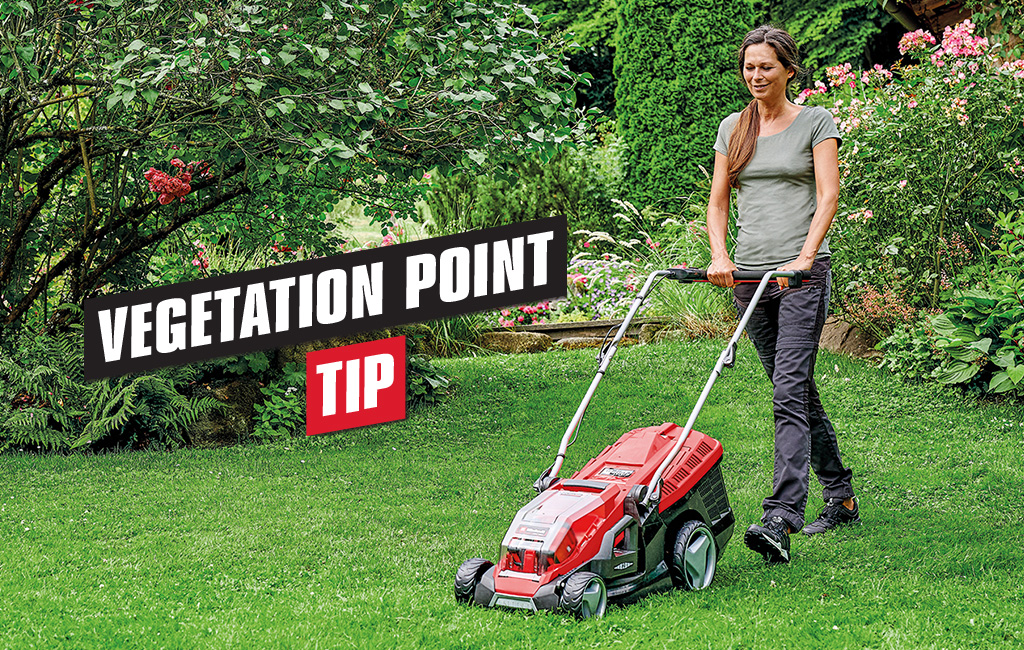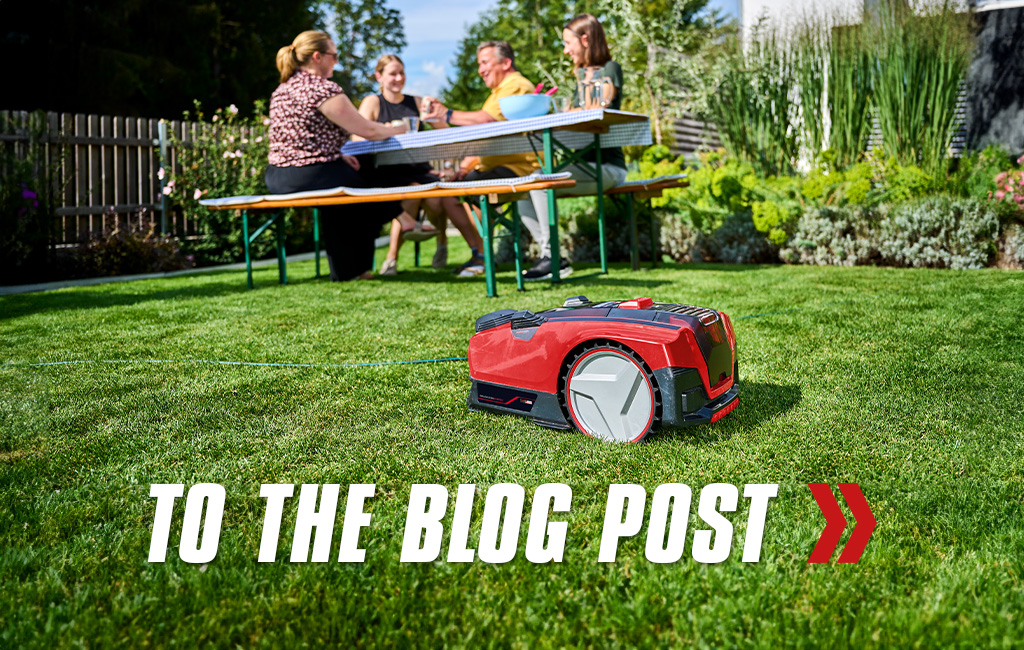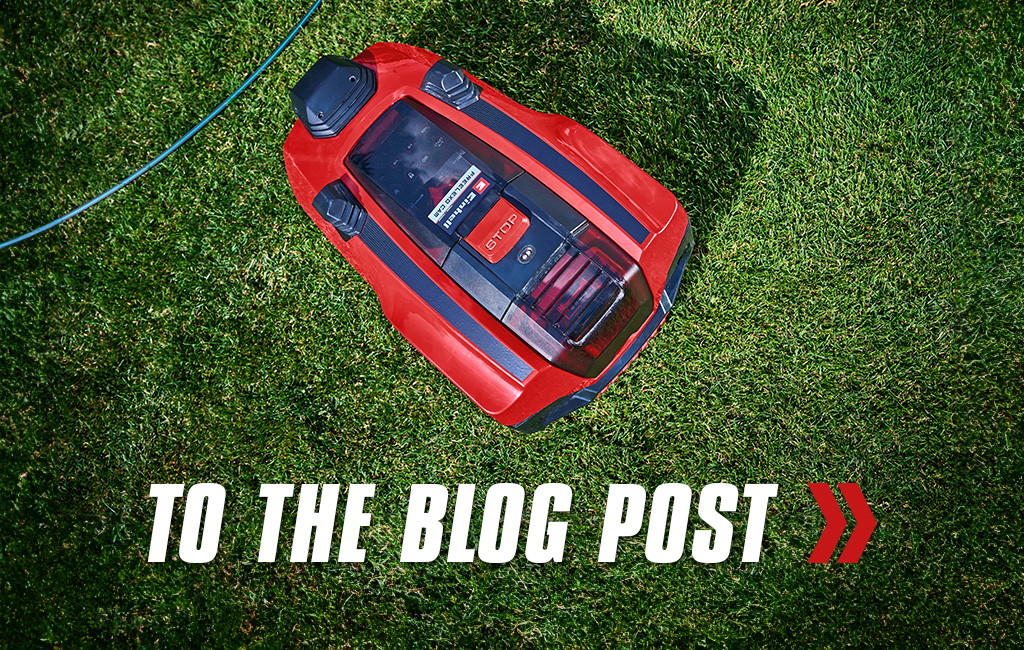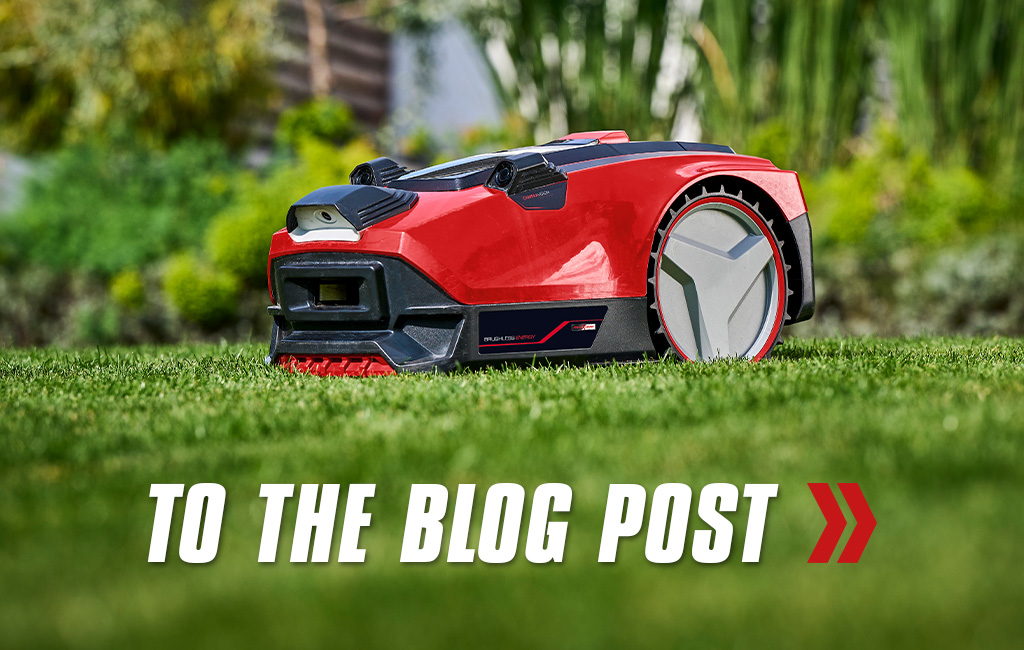Mowing the Lawn: Perfect Time and Proper Settings
Lush green, no moss, no brown or bare spots – a well-maintained lawn is the pride of every gardener. Along with aeration and fertilizing, mowing the lawn is the most crucial maintenance task because regular mowing stimulates the growth of grass plants and encourages them to grow thicker, creating the best conditions for a dense turf. In this blog post, we explain how and when to mow your lawn best, along with helpful tips.

The optimal cutting height for lawn mowing
While cylinder mowers or manual lawnmowers are very popular in other countries, rotary mowers, i.e., conventional petrol, electric, or battery lawnmowers, are predominantly used in German gardens, like our Einhell lawnmowers. These lawnmowers cut the grass with horizontally rotating blades. To ensure a clean cut and prevent frayed grass blades, the blades of the rotary mower must be very sharp. Therefore, you should sharpen or replace your lawnmower blades at least once a year. You can find suitable replacement blades in our online shop. You can either sharpen the blades in your home workshop or have them reconditioned by a specialist dealer. Just examine some grass blades to check. If you see fraying and uneven cuts, the blade is dull. Also, ensure a high engine speed when mowing. The higher the engine speed, the faster the blades rotate, and the cleaner the cut.
The cutting height on the lawnmower can usually be adjusted in several steps. These steps are generally not directly translatable to centimetres. For example, step 1 does not necessarily mean a cutting height of 1 cm. You can find out which step corresponds to which cutting height in your lawnmower's user manual. If you don't have it handy, you can mow a small piece—preferably in the shade—and then measure.
For a standard lawn that is used daily, a cutting height of 4 cm is optimal. Shady areas should be mowed one to two centimetres higher. This allows the grass plant more area for photosynthesis, enabling it to cope well with the reduced sunlight. Ornamental lawns can also be cut shorter to about 3 cm.

A too short cut damages the lawn, especially during dry periods. If it hasn't rained for a long time, you should also allow the grass to have slightly longer blades. If the grass is too short, the roots also suffer because they are no longer protected from direct sunlight. Too short blades and unprotected roots cause the lawn to dry out quickly and turn brown. Furthermore, further growth is an immense effort for too short mowed lawn plants. Mosses and weeds take advantage of this opportunity to displace the weakened plants in the garden and spread themselves. However, if you let the blades grow too long, you take away the incentive for further growth, and weeds spread. If weeds have already spread in your garden, we have summarized everything important in this blog post on how to get rid of the annoying wild growth.

TIP
Stick to the 1/3 rule for cutting height, which takes into account the natural growth of the grass blade. The growth point of the grass blade is approximately halfway up. If you cut this off, the shoot recovers more slowly, and the lawn grows patchily. Therefore, mow an overgrown lawn in several stages to avoid cutting too much at once and gradually move the growth point downward.
Excursus: Mowing the lawn with a robotic lawnmower
Just between us: a robotic lawnmower is a wonderful thing, isn't it? It runs quietly over your lawn day and night, keeping it perfectly trimmed and always lush and green. However, before the Einhell robotic mower can do its job, you should check how tall your grass is currently. If your lawn is taller than 6 cm, it's recommended to trim it with a battery-powered lawnmower or similar tool before the robot's first run. As mentioned above, the optimal cutting height for a regular lawn is 4 cm. You should trim it to this height to ensure you have the optimal length and the robotic mower can operate flawlessly. Alternatively, you can let your FREELEXO mow the entire lawn at its highest setting of 60 mm first, and then gradually lower the cutting height step by step until you reach the desired length. The cutting mechanism of all our Einhell robotic mowers can be adjusted continuously between 20 mm and 60 mm. For more information on robotic lawnmowers, you can also check our blog.
The Right Time to Mow the Lawn
Regular mowing ensures that the grass branches out at the base and forms a nice, dense surface. Under normal conditions, the rule of thumb is to mow once a week! However, this also depends on the weather, fertilization, watering, and the location in the garden.
Mowing the Lawn in Summer
In summer, regular mowing ensures optimal lawn growth and significantly slows down the growth of weeds. During the warm summer months, you should trim your lawn at least once a week – but not too short! A blade length of 5 cm effectively protects it from drying out. Never mow your lawn in the scorching midday sun; instead, opt for the cooler evening hours or early morning.
Mowing the Lawn in Autumn
To ensure that the lawn grows vigorously next spring, proper winter preparation is crucial. Mow the grass as long as the weather allows. The timing for the last mow depends on the temperature: as long as it doesn’t get too cold at night, the grass continues to grow. The first frost usually occurs in mid to late October – that’s the right time for the last cut. Trim the blades about half a centimetre more than usual. Remove the grass clippings to minimize the risk of fungi and diseases.
Mowing the Lawn in Winter
In winter, you can let your lawn rest. The grass grows very little to not at all during this time. However, make sure to regularly remove leaves so that the lawn gets enough light and the soil doesn't become too damp. This is especially important during prolonged frost, as frozen grass blades can break just by walking on the lawn, and it takes until spring for the lawn to recover from this damage.
Mowing the Lawn When It's Wet
You should avoid mowing the lawn when it’s wet, as moist leaves and blades often don’t get cut cleanly. This stresses the plants more than necessary, and the mowing pattern suffers because the clippings clump together and cannot be completely blown into the catcher. On the waterlogged ground, the wheels can sink and cause damage to the grassroots – the heavier the machine, the greater the risk.
Mowing the Lawn in Hot Weather
When temperatures rise above 30 °C, mowing the lawn is also not advisable as the soil would dry out too quickly. In the morning, the grass is usually still too moist, so the late afternoon is the perfect time for mowing. Afterward, you can conveniently water the freshly cut lawn.

Tips for Proper Mowing
- Avoid Stepping on Grass: Move only on the already mowed area while mowing the lawn. Grass blades need some time to stand back up after being trampled, so they may not be cut, or at least not at a uniform height.
- Utilize Full Cutting Width: Ensure you use the full cutting width of the lawnmower. This not only speeds up the mowing process but also results in a more even cut. Guide the lawnmower so that it always overlaps the previous mowing path by one wheel's width. This creates a seamless and stripe-free surface.
- Be Careful with Lawn Edges: If your lawn has a defined edge, be cautious not to let the mower wheels slip into the adjacent bed. Otherwise, the blade might cut chunks of the turf. To be safe, leave a narrow strip and trim it later with edging shears or a grass trimmer.
- Mowing Slopes Correctly: Always mow slopes perpendicular to the incline. This ensures an even cut and is safer, as the lawnmower stays at the same level as you, preventing it from rolling over you in case of a fall. For more tips, check out our blog post on mowing slopes.

Mulch as Fertilizer
Our final tip: If you mow your lawn frequently and only cut a few millimetres off the blades, you can leave the grass clippings on the lawn as mulch. This thin layer of grass cuttings acts as fertilizer, retains some water, and promotes the formation of humus and the crumb structure of the soil. In our blog post “Mulching: the Easy Way to a Healthy Lawn,” you can find more information on this topic. If an Einhell robotic mower is used for lawn care on your lawn, it does this automatically: by mowing at least once a day, it only cuts a small portion of the grass blades each time. The clippings then remain in your garden and fertilize the lawn.
In general, mulching only works if the grass is left as very short clippings. If this is not possible, you must collect the grass clippings, as they would otherwise suffocate the plants.

















